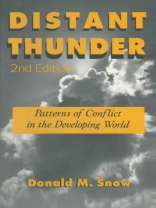The main locu of instability, conflict and violence in the post-Cold War world is the periphery – particularly the poorest regions of what used to be called the Third World. Internal wars of secession, struggles for power and chaos in failed or failing states are the dominant forms, expressed in intercommunal or ethnic violence, domestic and international acts of terrorism, and, increasingly, essentially criminal insurgencies with no political objective. This completely revised ed...
The main locu of instability, conflict and violence in the post-Cold War world is the periphery – particularly the poorest regions of what used to be called the Third World. Internal wars of secession, struggles for power and chaos in failed or failing states are the dominant forms, expressed in intercommunal or ethnic violence, domestic and international acts of terrorism, and, increasingly, essentially criminal insurgencies with no political objective. This completely revised edition of "Distant Thunder" brings the problem of Third-World conflict into the post-Cold War era. Now that the periphery is no longer the site of surrogate competitions between rival political-economic systems, when and how should the developed countries intervene in internal wars outside the compass of their traditional geopolitical interest – and what can such intervention be realistically expected to accomplish? The new edition shows how secessionist and ethnic conflicts, terrorism and the drug trade fit into the context of international politics, examines the post-Cold War dynamics of political and economic decline, state failure, and the limits of interventionism, includes case studies of the Shining Path of Peru and its degeneration from a Maoist-type insurgency to a narco-terrorist ring and the Somali crisis as examples of the difficulties of international intervention in internal wars.












